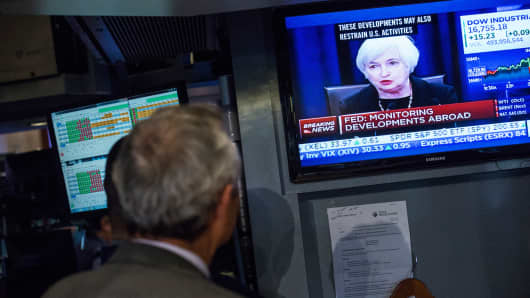Global equities are down more than 10 percent from their peak in June, the largest fall since 2011, leading investors to question the ability of central banks to protect downside and push markets higher. But while markets have reacted badly to the notion that central banks have lost their mojo, we believe investors are underestimating central bank capacity to influence markets.
The progress made toward recovery has been largely overlooked, whereas the magnitude and breadth of the weak economic data has been overanalyzed. We believe disappointing data represents a mid-cycle slowdown, not a slide into recession. A combination of improving readings from the U.S. and a gradual recovery in China should help restore faith in the global growth picture.
First, central banks have the power to do more in a low-inflation environment.
China still can trim its one-year official interest rate, making debt servicing easier, and lower its reserve requirement ratio, permitting banks to lend more.
In the euro zone, European Central Bank President Mario Draghi has been explicit in his willingness to unveil bigger monetary policy guns, saying on Sept. 3 that "the size, composition and duration" of quantitative easing could all be enlarged. We consider it likely that the Bank of Japan's asset purchase program, running at 80 trillion yen ($663 billion) annually, will be increased in response to low inflation readings.
And in the U.S., while debate rages about the merits of the Federal Reserve's recent non-decision, Chair Janet Yellen and her colleagues have proven they are flexible enough to maintain ultra-low interest rates if they see fit.
Second, we should remember that stimulus takes time to feed through into hard data.
In China, the benefits of measures — such as increased fiscal spending, recent cuts to reserve-ratio requirements, and credit-asset securitization schemes — are still working their way through the economy.
In the euro zone, ongoing quantitative easing is stimulating lending: loan flows to households and non-financial corporations have been the strongest in four years.
And in the U.S., gasoline prices have fallen by 17 percent since the middle of the year. So, for many Americans, a gallon of gas is now cheaper than bottled water. Mortgage rates have dropped by almost 0.4 percentage points, further depressed by the Fed's non-action. Worldwide, then, the delayed effects of previous easing cycles should still help economies later in the year.
Finally, economic data has not deteriorated to the extent that a great deal of additional stimulus is required. Most of the weakness is confined to the manufacturing sector, which makes up just 12 percent of U.S. GDP and 19 percent of German GDP. Even in China, commonly perceived as a manufacturing powerhouse, it represents just 31 percent of value added in the economy.
We are encouraged by signs of a stabilization of China's housing market, with prices rising in 35 out of 70 cities in August. Given that about 40 percent of household wealth is held in property, this bodes well for consumer spending.
Retail-sales growth is on track to remain above 10 percent. In developed economies manufacturing weakness is being balanced by service sector-strength, with non-manufacturing purchasing managers' indices in the euro zone at 53.9 and 59 in the U.S. The non-manufacturing Institute for Supply Management index in the U.S., for example, has opened up the widest gap against the manufacturing gauge since 2008.
Overall, we believe weak economic data does not justify the steep slide in markets.
In times when both growth and rising rates are a concern, asset-class diversification can fail in its customary function of stabilizing portfolios. Recent weeks have been one such time, with equities falling and bonds offering less support than we would normally expect under conditions of heightened risk aversion. Yet such periods do not last indefinitely, which is why we believe diversification — both across regions and in terms of asset classes — is important.
With upcoming numbers likely to reflect ongoing economic and earnings growth, we expect developed market equities, in particular in the euro zone and Japan, to move higher over the next six months.
Commentary by Mark Haefele, global chief investment officer at UBS Wealth Management, overseeing the investment strategy for $2 trillion in invested assets. Follow UBS on Twitter @UBSamericas.





